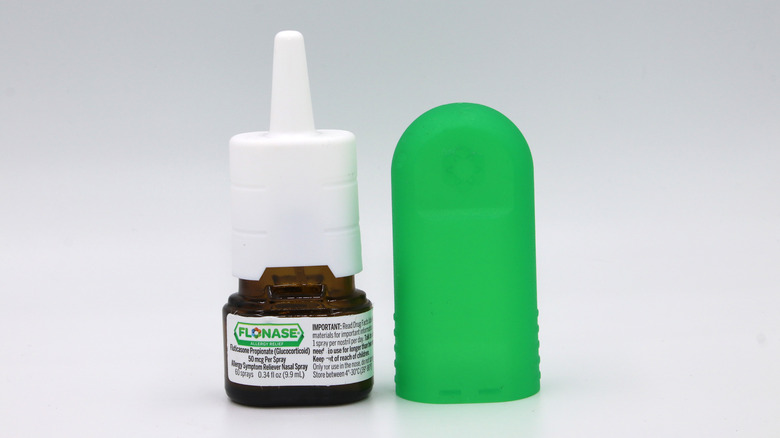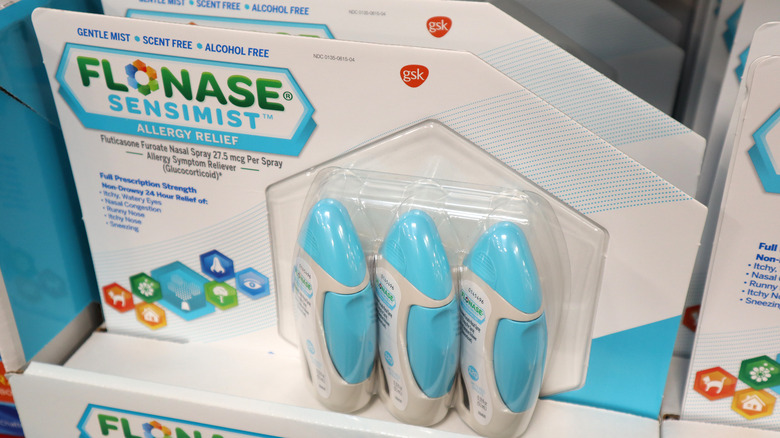This Is How Long It Takes For Flonase To Start Working
Flonase is a brand name for the drug fluticasone, which helps treat various allergic and nonallergic symptoms such as sneezing, nasal polyps, itching, and runny nose (via MedlinePlus). The Asthma and Allergy Foundation of America estimates about 50 million Americans experience allergies each year. In fact, allergies are now the sixth leading cause of chronic illness in the United States. While there's no cure for allergies, Flonase can be of great help when treating symptoms.
According to the Cleveland Clinic, fluticasone belongs to a group of drugs called nasal steroids, which decrease nasal inflammation. Since allergy symptoms stem from an inflammation of the nose, fluticasone can effectively treat allergy symptoms. The drug is available in both prescription and nonprescription forms.
If you have recently picked up this medication, you might be wondering how long it takes for Flonase to start working. Continue reading as we break down the finer details.
How long does it take for Flonase to start working?
According to a 2001 review published in The Annals of Allergy, Asthma, & Immunology, it may take as few as two to four hours for Flonase to kick in, even though the drug's onset of therapeutic effect actualizes for most patients within 12 hours after the first dose.
Going beyond the recommended dose will not make the drug more effective. Rather, responsibly using Flonase at the suggested intervals can lead to maximum effects (via Drugs.com).
According to the Mayo Clinic, prescriptions may differ from one user to another. As a guide, many adults require one spray in each nostril twice daily, or two sprays in each nostril once a day. When taking the medicine, it's important to follow your doctor's instructions or those provided inside the packaging for more clarity on how to use it.
Mayo Clinic advises to lean your head back slightly and close one nostril with a finger while releasing the spray into the other. Also, hold your breath for a few seconds after inhaling the spray and breathe slowly through your mouth. Alternatively, consult with your doctor or pharmacist if you're unsure.
Potential side effects of Flonase
According to Drugs.com, potential side effects of Flonase include nosebleeds, sore throat, headache, and nasal burning or itching. Some less common but severe side effects include breathing difficulties, muscle weakness, and slow wound healing (via Healthline).
Flonase can also aggravate asthma symptoms and lead to serious complications such as sinusitis, upper respiratory tract infections, and bronchitis, as explained by Medical News Today.
Some concerns have also been raised about the long-term use of Flonase. According to Medical News Today, the drug might be linked to osteoporosis and slow growth in children. It's also been associated with a number of eye defects including glaucoma and cataracts.
As explained by a 2022 review published in StatPearls, about 10% to 20% of inhaled corticosteroids like Flonase can make their way to the lungs, meaning the remaining 80% to 90% pass through the GI tract, hence the systemic side effects like glaucoma, osteoporosis, and adrenal suppression. According to the study, the drug is also linked to lung-related complications like pneumonia and voice disturbances.
While serious side effects are uncommon, Healthline suggests talking to your doctor if you experience concerning side effects or side effects that last longer than a few days. People with severe side effects should receive emergency medical care, notes Medical News Today.



